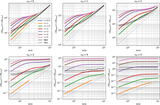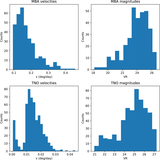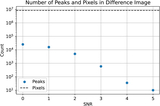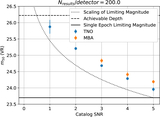Image Details

Caption: Figure 7.
The m50 depth from fitting of the completeness (left), the number of candidate detections produced per detector (middle), and the number of synthetic objects (fakes) recovered (right) for the TNO and MBA searches as a function of the ﹩{N}_{{\rm{\min }}}﹩ parameter. The solid black line visualizes the estimated single-epoch m50 = 23.7. The dashed black line represents the theoretical achievable depth by coadding all of the images and is equal to ﹩{m}_{50}^{{\rm{coadd}}}=26.2﹩. Decreasing the value of ﹩{N}_{{\rm{\min }}}﹩ increases m50 depth and the number of synthetic objects recovered, at the cost of vastly increasing the number of results produced. Most of the results produced at low values of ﹩{N}_{{\rm{\min }}}﹩ are false-positive candidates.
Copyright and Terms & Conditions
© 2025. The Author(s). Published by the American Astronomical Society.












